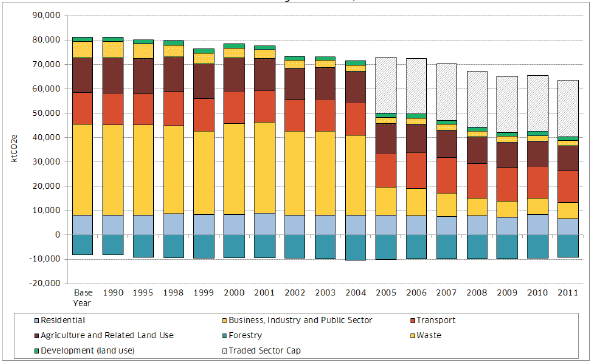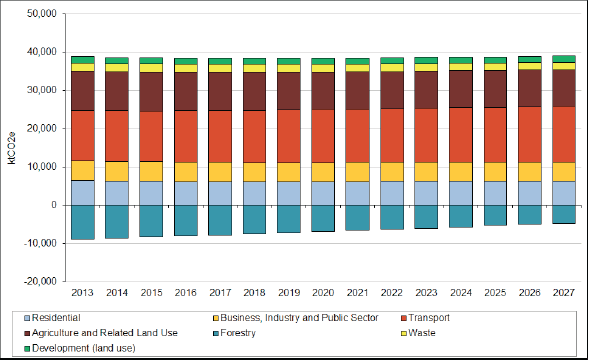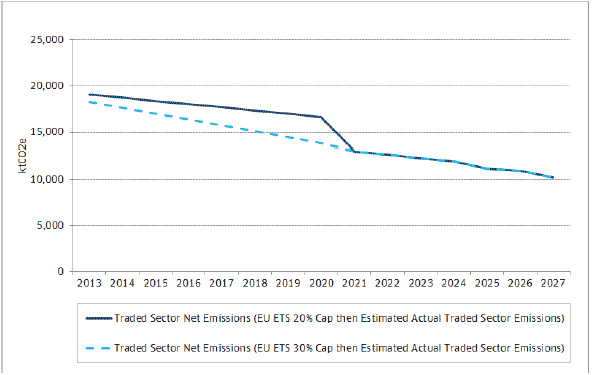Low Carbon Scotland - meeting our emissions reduction targets 2013-2027: second report
This is our second report on proposals and policies (RPP2) for meeting our climate change targets.
3. Part 2: Historical Emissions Data and the Business-as-Usual Future Emissions Projections
3.1 Historical Emissions Data
3.1.1 The official source of GHG emissions data that is used by the Scottish Government is the National Atmospheric Emissions Inventory ( NAEI). [5] The NAEI compiles estimates of emissions to the atmosphere from UK sources. This data is disaggregated to a regional level and the Scottish estimates are published annually with approximately an 18 month lag in the Greenhouse Gas Inventory. [6] The time series of data runs from 1990 with the latest Scottish GHG emissions estimates for 2011 published in June 2013. Data from the NAEI has been used as the basis for setting the Scottish annual GHG emissions targets and for assessing progress against the targets.
Traded and Non-Traded Emissions
3.1.2 The advent of the European Union Emissions Trading Scheme ( EU ETS) in 2005 meant that emissions were split into those accounted in the 'Traded' sector and those in the 'Non-Traded' sector. Emissions in the traded sector ( EU ETS) include GHG emissions from the generation of electricity, energy intensive business and industrial processes such as production of steel and iron, and energy intensive parts of the public sector such as large hospitals. In 2011, 98% of GHG emissions from the Energy Supply sector were estimated to be traded, alongside 49% of the business and industry sector's emissions and 21% of the public sector's emissions.
3.1.3 The non-traded sector emissions include all other GHG emissions captured in the NAEI in Scotland that are not in the traded sector. These are disaggregated into the following sources of emissions: residential, non-traded business, industry and public sector, transport, agriculture and related land use, forestry, waste sector, and development (land use).
3.1.4 Chart 1 below shows historical Scottish emissions by sector. The start of the EU ETS can be seen in 2005 when more than half the emissions from the Business, Industry and Public Sector category moved into the Traded Sector.
Chart 1: Scottish GHG Emissions by Sector, 1990 - 2011

Source: GHG Inventory ( NAEI), 2013 [7]
3.2 Future Emissions Projections
Non-Traded Sector
3.2.1 The BAU GHG emissions projection for Scotland is the first step in establishing the scale of abatement that is required to meet future annual GHG emissions targets. The full process is to construct a BAU GHG emissions profile for Scotland then net off the abatement potential from the policies and proposals identified in order to meet the emissions targets that have been set. Details of the abatement potential from policies and proposals are set out in Part 3 of this appendix.
3.2.2 The BAU scenario is an estimate of what emissions in Scotland are most likely to be each year between 2013 and 2027 based on NAEI data and the on-going effects of policies implemented up to the 2006 UK and Scottish Climate Change Programmes.
3.2.3 The non-traded sector BAU emissions projections are estimated at a sectoral level as detailed above. The basis of the BAU projections is the 2010 'outturn' data from the NAEI. An estimate of 2011 Scottish sectoral emissions was calculated by applying the percentage change in emissions observed at a UK level between 2010 and 2011. [8] From 2012 to 2027 BAU emissions were calculated for each sector, for CO 2 and non-CO 2 emissions, using a range of projection tools and sources. Details of these are set out below.
Scenario Tool of Emissions Projections for Scotland ( STEPS)
3.2.4 The STEPS model was commissioned by the CCC and developed by Cambridge Econometrics ( CE). The model provides Scottish BAU CO 2 projections for the non-traded sector out to 2030. [9]
3.2.5 The STEPS model has been used to create CO 2 BAU projections from 2013 to 2027 for the Residential sector, non-traded Business, Industry and Public sector, and Transport (not including aviation).
3.2.6 To generate the most robust estimates possible for Scotland, the STEPS model is informed by two Scottish Government models: Domestic Emissions Model for Scotland ( DEMScot), which is particularly geared for the Scottish residential sector, and the Transport Model for Scotland ( TMfS), which inputs Scottish specific data on vehicle fleet mix and efficiency.
3.2.7 Aviation is the only mode of transport for which projected GHG emissions are not estimated by the STEPS model. From 2012, aviation CO 2 emissions are captured in the EU ETS. As such, for the purposes of modelling their impact on Scotland's GHG emissions, aviation BAU emissions have been assumed to follow the capped trading amount of 97% of the 2004 - 2006 average aviation emissions in 2012 falling to 95% of the same average from 2013 onwards. [10]
Non-CO 2 Emissions Projections
3.2.8 The CCC commissioned AEA to provide non-CO 2 BAU projections for Scotland and the other countries within the UK. [11] This analysis provides projections for 2010, 2015, 2020 for all non-CO 2 emissions arising in Scotland. To derive the annual projection, the 5-yearly results have been linearly interpolated over the years to 2027.
3.2.9 The AEA projections are used to provide non-CO 2 projections for Residential, Business, Industry and Public Sector, the Agriculture Industry element of Agriculture and Related Land Use, Transport and Waste.
Land Use, Land Use Change and Forestry ( LULUCF)
3.2.10 The LULUCF [12] emissions projections are based on the work of the Centre for Ecology and Hydrology ( CEH) [13] which produces a national inventory and projections of emissions by sources and removals of GHGs at a range of spatial scales. This feeds into the NAEI.
3.2.11 Its latest report provides projections to 2050 on carbon stock changes (resulting in net CO 2 emissions) and CO 2, Carbon Monoxide (CH 4) and Nitrous Oxide (N 2O) emissions arising from LULUCF activities reported in the latest NAEI. [14] Following a request by the Scottish Government, the scenarios were modified to include continuing cropland-grassland turnover (crop-rotation). In RPP2 the CEH projections were used to provide CO 2 and non-CO 2 projections for Agriculture Related Land Use, Forestry and Development (land use).
Food and Agriculture Policy Research Institute ( FAPRI)
3.2.12 The FAPRI UK modelling system captures the dynamic interrelationships among the variables affecting supply and demand in the main agricultural sectors of England, Wales, Scotland and Northern Ireland. [15] The model consists of a system of equations covering the dairy, beef, sheep, pigs, poultry, wheat, barley, oats, rapeseed and bio-fuel sectors and generates annually-determined, 10-year baseline projections of all the major agricultural commodity prices, production levels and GHG emissions, against which policy scenarios can be compared.
3.2.13 In RPP2, FAPRI is used to generate non-CO 2 emission projections for the Scottish Agriculture sector.
3.2.14 Table 2 presents a summary of the tools used to project non-traded BAU emissions in RPP2 and Chart 2 illustrates the non-traded BAU projections by sector.
Table 2 : Summary of Sources used to Estimate Non-Traded Scottish Business-as-Usual Emissions
| Sector | CO 2 | Non-CO 2 |
|---|---|---|
| Residential | STEPS | AEA |
| Business, Industry and Public Sector | STEPS | AEA |
| Transport | STEPS | AEA |
| Agriculture and Related Land Use | STEPS and LULUCF | FAPRI and LULUCF |
| Forestry | LULUCF | LULUCF |
| Waste | AEA | AEA |
| Development (land Use) | LULUCF | LULUCF |
Chart 2: Non-Traded Scottish Business-as-Usual Emissions Projection by Sector, 2013 - 2027

Source: Scottish Government, 2012/13
The Traded Sector
3.2.15 Estimating a future emissions projection for the traded sector has been split into two parts. From 2013 to 2020, the traded sector is presented as per the EU ETS and Scotland's share of the trading scheme's declining permit allocation is used as the emissions profile for the traded sector. From 2021 to 2027, there are no details on the nature of the EU ETS, and so an estimate of 'net traded sector emissions' has been presented. This is constructed from a projection of actual electricity generation emissions in Scotland in its transition to a sectoral emissions intensity of 50g/kWh in 2030 and from the CCC second target advice that identifies abatement from non-electricity generation traded industry (e.g. refineries). The traded sector emissions profile already builds in abatement, initially through the assumed price mechanism and permit supply in the EU ETS up to 2020, and thereafter as a result of progressing on to 50g/kWh. As such, no additional emissions abatement is deducted from the traded sector profile.
3.2.16 Chart 3 illustrates the traded sector emissions profile for Scotland.
Chart 3: Net Traded Sector Emissions, 2013 - 2027

Source: Scottish Government, 2012
3.3 Uncertainty of Emissions Projections
3.3.1 The BAU emissions projections for the traded and non-traded sectors have a significant level of uncertainty around them, which naturally increases the further into the future the projection stretches. The projections out to 2027 are based on a wide range of assumptions associated with issues such as future economic circumstances, energy consumption, land use changes, consumer behaviours and natural uptake of current policies. All assumptions made have been based on the most up to date emissions data available at a Scottish level and our best understanding of future circumstances through the projection tools used. However, the research and data associated with GHG emissions and their sources are fast evolving, which can have a significant effect on the profile of BAU emissions projections as the updates are incorporated. [16]
3.3.2 This high level of uncertainty also feeds into the abatement potential of policies and proposals that are set out in Part 3. A range of assumptions have had to be made about the potential uptake of measures and the financial investments that could be required to achieve the abatement potential detailed. Some of the policies and proposals are very much dependent upon changes in consumer behaviour, which is a particular source of uncertainty. The next section makes clear the sector specific uncertainties that exist with the emission abatement and investment projections and the assumptions (and sources) that have been used to provide credible emissions profiles.
Contact
There is a problem
Thanks for your feedback